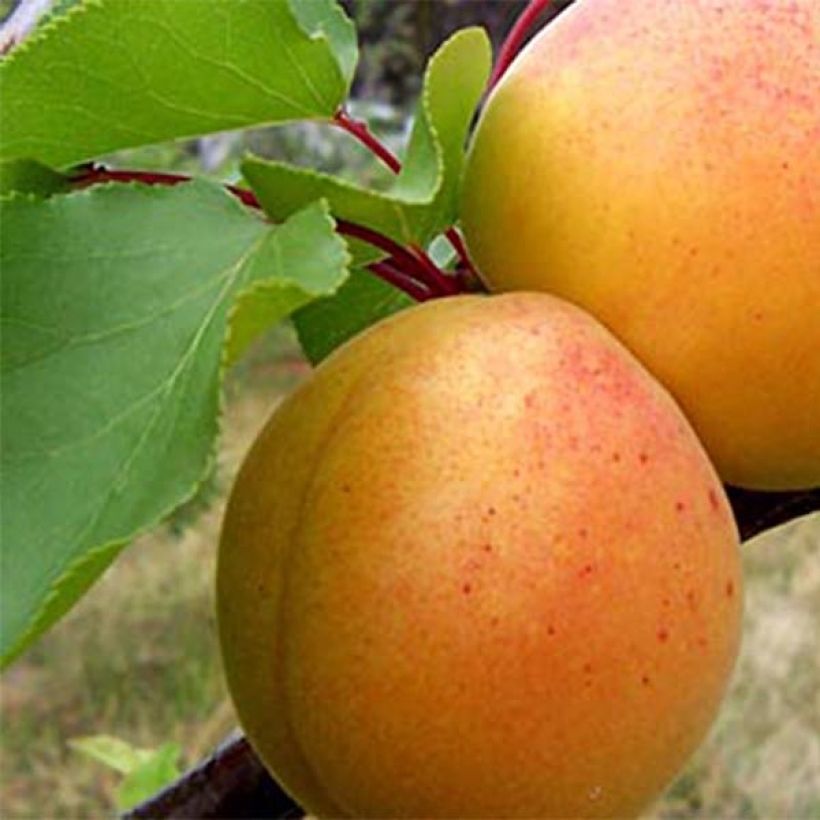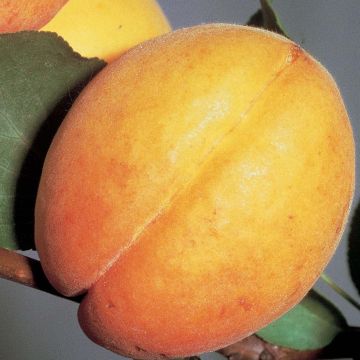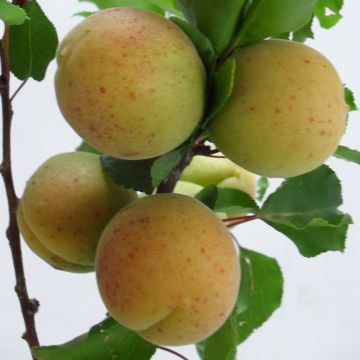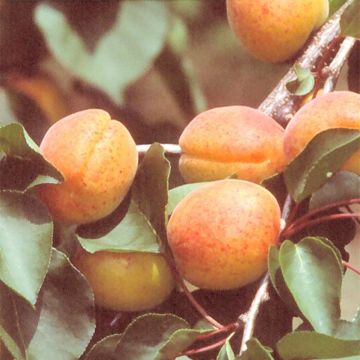

Abricotier Précoce de Saumur Bio en racines nues, forme scion
Prunus armeniaca Early Saumur Organic - Apricot Tree
Prunus armeniaca Précoce de Saumur
Apricot
la floraison a été extraordinaire même si les abricots n'ont pas survécu au gel malgré un triple voile de protection, mais la plante va bien. Mes abeilles et les premiers papillons donnent une très bonne note à cette plante
Marie-Antoinette A., 26/04/2017
This item cannot be shipped to the selected country
Oversize package delivery charge from €6.90
Delivery to Corse prohibited
More information
Schedule delivery date,
and select date in basket
This plant carries a 6 months recovery warranty
More information
We guarantee the quality of our plants for a full growing cycle, and will replace at our expense any plant that fails to recover under normal climatic and planting conditions.
Oversize package: home delivery by special carrier from €6.90 per order..
Express home delivery from €8.90.
Delivery to Corse prohibited: UE law prohibits the import of this plant from mainland France to Corse as part of the fight against Xylella fastidiosa. Please accept our sincere apologies.
More information
Description
The Organic Early Saumur Apricot Tree is a self-fertile variety from Organic Agriculture, hardy and particularly productive. Its fruits, a beautiful orange colour that turns red in the sun, measure 4 to 4.5 cm (2in) in diameter and have a slightly juicy but fine, melting, sweet and deliciously fragrant flesh. They are highly appreciated fresh, but also in pastries or dried. The tree is superb in March-April, covered with abundant light pink flowering. The flowers and young fruits can withstand small frosts of around -3°C (26.6°F). The fruits will be harvested from late June and throughout the month of July.
The apricot tree, in Latin Prunus armeniaca, is native to Central and Eastern Asia. It has been cultivated in China for 3,000 years before Christ. The apricot tree we cultivate was introduced to the Mediterranean basin from Armenia, hence its name, at the beginning of the Christian era. Its introduction to France took place during the Renaissance. In the 1960s, a chance seedling, discovered following the demolition of a wall, revealed an apricot tree growing on an embankment in the Saumur region. The Early Saumur Apricot Tree was born.
The Early Saumur Apricot Tree has hardiness that allows it to withstand temperatures as low as -18°C (-0.4°F). However, it should be planted in a sunny location and protected from North and East winds to prevent flower frost at -3.5°C (25.7°F).
Naturally, the apricot tree has a rounded habit, forming a dome. The branches grow in all directions in a regular manner, hiding 2/3 of the trunk height. The leaves are toothed, heart-shaped, and have long petioles. It can reach up to 6m (20ft) in height with a diameter of 4m (13ft). The tree starts producing fruit at 3 years old and becomes fully mature at 7 years old.
The flowering of this apricot tree occurs in March, before the leaves appear. It is carried by the previous year's branches. The flower has 5 pink petals and purple sepals. It is fragrant but lasts only a short time. The fruits will be ripe from late June and during the first weeks of July.
The Early Saumur Apricot Tree is self-fertile. It does not require the presence of another apricot tree for pollination. It will be an excellent pollinator for your cross-pollinating apricot trees.
Apricots are consumed fresh, dried, or prepared in various ways: jams, pies, compotes, apricots in syrup, etc. They are also used in savoury dishes, such as rabbit with apricots and parsnips, an English recipe. Apricot juice is often mixed with a touch of peach juice to balance the natural acidity of the apricot.
Designed for organic cultivation, the cultivation of the Organic Early Saumur Apricot Tree will achieve better development under certain conditions. To prevent diseases and pests, you will need to:
- Space the trees 6m (20ft) apart in all directions,
- Choose a deep, light, rich, and well-draining soil,
- Avoid planting in an area that has hosted other woody plants or vegetable species such as melon, eggplant, and alfalfa,
- Prune, preferably in a goblet shape to promote ventilation,
- Thin out to prevent disease development on the fruits,
- Add compost in limited quantities in autumn, depending on the richness of your soil,
- Install multi-species hedges (except prunus) and nesting boxes (birds, voles, and bats) to attract beneficial insects.
In case of diseases, it will be necessary to remove and burn the affected parts. Against the most common disease, brown rot, a preparation of plants (nettle, horsetail, fern, etc.) is recommended, although the most effective treatment is Copper, to be used sparingly. Against Sharka and peach leaf curl, there is no treatment available: uprooting and burning is the only solution to prevent transfer to your other trees.
For transportation reasons, our tallest scions may be pruned before shipping. They are suitable for all common training sizes: cordons, espaliers, goblets, half-standards, and low standards, except for high standards. If you would like more information or advice on the training of your fruit trees, please do not hesitate to contact us.
Report an error about the product description
Prunus armeniaca Early Saumur Organic - Apricot Tree in pictures


Plant habit
Fruit
Flowering
Foliage
Botanical data
Prunus
armeniaca
Précoce de Saumur
Rosaceae
Apricot
Western Europe
Other Apricot trees
Planting and care
Planting should preferably take place at the beginning of winter, when the tree is in a vegetative rest period, and before the frosts. To plant several apricot trees, space them at least 1.5 m (5ft) apart. Dig a hole two to three weeks before planting, twice as wide and deep as the pot. On the day, place the tree with its pot in a basin of water, in order to moisten the entire root ball by capillarity. Add compost to the bottom of the hole. Plant the tree in the hole, fill with soil mixed with compost. Firmly tamp down at the base. The root ball should be completely covered. Water abundantly.
The Organic Early Saumur Apricot Tree is demanding when it comes to the deep nature of the soil. It will ideally thrive in a rich and light, damp, and above all well-drained soil: it does not tolerate waterlogged soil. Plant it in a sunny location, sheltered from the north and east winds.
Planting period
Intended location
Care
-
, onOrder confirmed
Reply from on Promesse de fleurs
Haven't found what you were looking for?
Hardiness is the lowest winter temperature a plant can endure without suffering serious damage or even dying. However, hardiness is affected by location (a sheltered area, such as a patio), protection (winter cover) and soil type (hardiness is improved by well-drained soil).

Photo Sharing Terms & Conditions
In order to encourage gardeners to interact and share their experiences, Promesse de fleurs offers various media enabling content to be uploaded onto its Site - in particular via the ‘Photo sharing’ module.
The User agrees to refrain from:
- Posting any content that is illegal, prejudicial, insulting, racist, inciteful to hatred, revisionist, contrary to public decency, that infringes on privacy or on the privacy rights of third parties, in particular the publicity rights of persons and goods, intellectual property rights, or the right to privacy.
- Submitting content on behalf of a third party;
- Impersonate the identity of a third party and/or publish any personal information about a third party;
In general, the User undertakes to refrain from any unethical behaviour.
All Content (in particular text, comments, files, images, photos, videos, creative works, etc.), which may be subject to property or intellectual property rights, image or other private rights, shall remain the property of the User, subject to the limited rights granted by the terms of the licence granted by Promesse de fleurs as stated below. Users are at liberty to publish or not to publish such Content on the Site, notably via the ‘Photo Sharing’ facility, and accept that this Content shall be made public and freely accessible, notably on the Internet.
Users further acknowledge, undertake to have ,and guarantee that they hold all necessary rights and permissions to publish such material on the Site, in particular with regard to the legislation in force pertaining to any privacy, property, intellectual property, image, or contractual rights, or rights of any other nature. By publishing such Content on the Site, Users acknowledge accepting full liability as publishers of the Content within the meaning of the law, and grant Promesse de fleurs, free of charge, an inclusive, worldwide licence for the said Content for the entire duration of its publication, including all reproduction, representation, up/downloading, displaying, performing, transmission, and storage rights.
Users also grant permission for their name to be linked to the Content and accept that this link may not always be made available.
By engaging in posting material, Users consent to their Content becoming automatically accessible on the Internet, in particular on other sites and/or blogs and/or web pages of the Promesse de fleurs site, including in particular social pages and the Promesse de fleurs catalogue.
Users may secure the removal of entrusted content free of charge by issuing a simple request via our contact form.
The flowering period indicated on our website applies to countries and regions located in USDA zone 8 (France, the United Kingdom, Ireland, the Netherlands, etc.)
It will vary according to where you live:
- In zones 9 to 10 (Italy, Spain, Greece, etc.), flowering will occur about 2 to 4 weeks earlier.
- In zones 6 to 7 (Germany, Poland, Slovenia, and lower mountainous regions), flowering will be delayed by 2 to 3 weeks.
- In zone 5 (Central Europe, Scandinavia), blooming will be delayed by 3 to 5 weeks.
In temperate climates, pruning of spring-flowering shrubs (forsythia, spireas, etc.) should be done just after flowering.
Pruning of summer-flowering shrubs (Indian Lilac, Perovskia, etc.) can be done in winter or spring.
In cold regions as well as with frost-sensitive plants, avoid pruning too early when severe frosts may still occur.
The planting period indicated on our website applies to countries and regions located in USDA zone 8 (France, United Kingdom, Ireland, Netherlands).
It will vary according to where you live:
- In Mediterranean zones (Marseille, Madrid, Milan, etc.), autumn and winter are the best planting periods.
- In continental zones (Strasbourg, Munich, Vienna, etc.), delay planting by 2 to 3 weeks in spring and bring it forward by 2 to 4 weeks in autumn.
- In mountainous regions (the Alps, Pyrenees, Carpathians, etc.), it is best to plant in late spring (May-June) or late summer (August-September).
The harvesting period indicated on our website applies to countries and regions in USDA zone 8 (France, England, Ireland, the Netherlands).
In colder areas (Scandinavia, Poland, Austria...) fruit and vegetable harvests are likely to be delayed by 3-4 weeks.
In warmer areas (Italy, Spain, Greece, etc.), harvesting will probably take place earlier, depending on weather conditions.
The sowing periods indicated on our website apply to countries and regions within USDA Zone 8 (France, UK, Ireland, Netherlands).
In colder areas (Scandinavia, Poland, Austria...), delay any outdoor sowing by 3-4 weeks, or sow under glass.
In warmer climes (Italy, Spain, Greece, etc.), bring outdoor sowing forward by a few weeks.











































